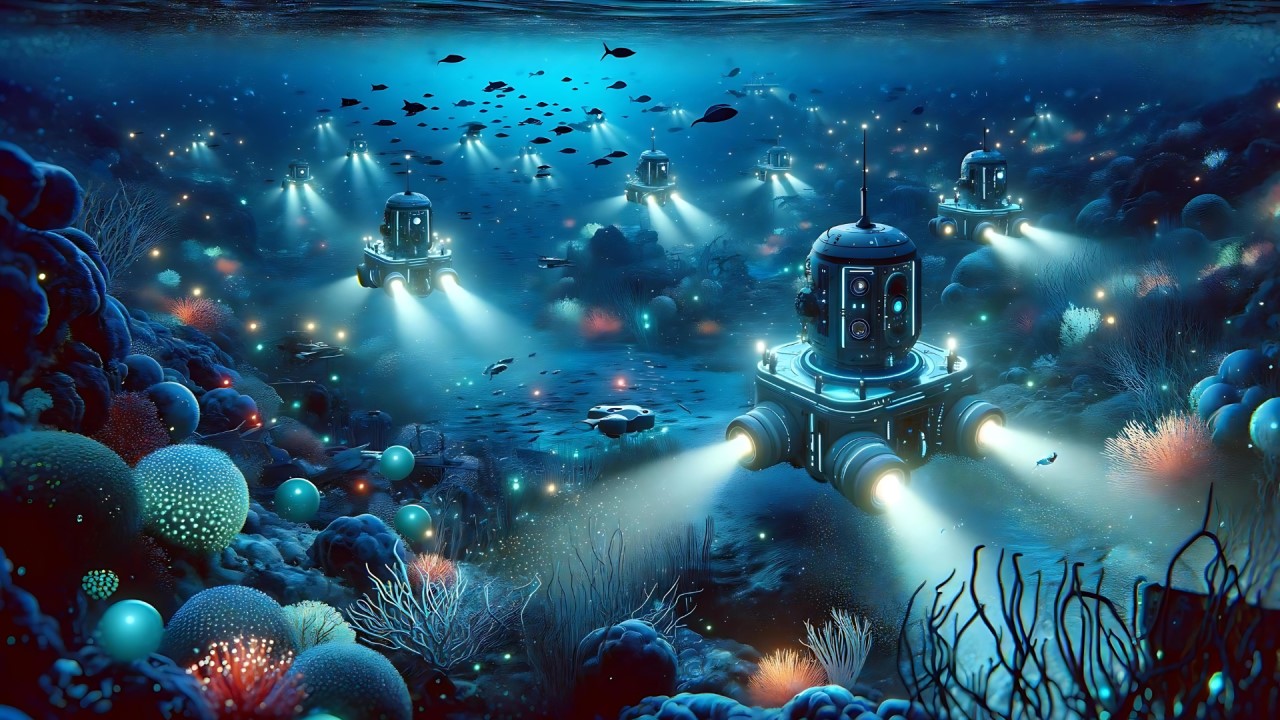Future Missions and AI Innovations
As our understanding of ocean worlds expands, so does the need for advanced technologies to explore these mysterious environments. Future missions, equipped with cutting-edge AI innovations, aim to unravel the secrets of these oceans, whether on Earth or distant moons. This part explores the planned missions, the AI technologies they will utilize, and the collaborative efforts driving these advancements.

Figure 1. Future Missions and AI Innovations
Detailed Look at Planned Missions to Ocean Worlds
Europa Clipper Mission:
Objective: Figure 1 shows Future Missions and AI Innovations. To explore Jupiter's moon Europa, focusing on its ice shell and subsurface ocean.
AI Application: Autonomous navigation and data analysis will allow the spacecraft to conduct detailed reconnaissance of Europa’s surface, identifying potential landing sites and regions of interest for future missions.
Dragonfly Mission to Titan:
Objective: To study the surface and atmosphere of Saturn’s moon Titan, particularly its hydrocarbon lakes and seas.
AI Application: The Dragonfly drone will use AI for autonomous flight, navigation, and data collection, adapting its mission plan based on real-time analysis of Titan’s terrain and atmospheric conditions.
Enceladus Life Finder (ELF):
Objective: To investigate the plumes of water ice and organic compounds ejected from Saturn’s moon Enceladus.
AI Application: AI-driven instruments will analyze the composition of the plumes, searching for biosignatures and other indicators of potential habitability.
Cutting-edge AI Tools for Exploration and Research
AI-enhanced Autonomous Systems:
Description: AI will drive the next generation of autonomous underwater and aerial vehicles, improving their ability to navigate complex environments and make decisions without human intervention.
Applications: Used in both terrestrial and extraterrestrial missions, these systems can adapt to unexpected challenges and optimize their exploration strategies.
Real-time Data Processing and Analysis:
Description: AI algorithms capable of processing vast amounts of data in real time will be crucial for future missions.
Applications: Enables immediate analysis of environmental data, such as chemical compositions or biological signals, allowing missions to respond dynamically to new discoveries.
Predictive Modeling and Simulation:
Description: Advanced AI models will simulate various scenarios, predicting environmental conditions and potential outcomes.
Applications: Helps in mission planning and risk assessment, ensuring that missions are better prepared for the conditions they will encounter.
Machine Learning for Biosignature Detection:
Description: Machine learning algorithms designed to detect patterns indicative of life, based on training from terrestrial analogs.
Applications: Identifies potential biosignatures in data from ocean worlds, aiding in the search for extraterrestrial life.
Collaboration Between Space Agencies, Research Institutions, and Private Companies
NASA and ESA:
Projects: Collaborative missions such as the Europa Clipper and JUICE (JUpiter ICy moons Explorer).
Focus: Combining resources and expertise to enhance mission capabilities, particularly in AI and autonomous systems.
Research Institutions:
Role: Universities and research centers contribute to the development of AI technologies and scientific instruments.
Impact: Drive innovation through cutting-edge research and experimentation, providing the theoretical and practical foundations for future missions.
Private Companies:
Contribution: Companies like SpaceX, Blue Origin, and others provide advanced technology and launch capabilities.
Impact: Accelerate the development and deployment of AI-driven exploration tools, reducing costs and increasing the frequency of missions.
Future Prospects and Innovations
AI in Surface and Subsurface Exploration:
Description: AI-powered rovers and submersibles will explore the surfaces and subsurfaces of ocean worlds, gathering detailed data and making real-time decisions.
Prospect: These technologies will enable more thorough and efficient exploration, increasing the chances of significant discoveries.
Integration of Quantum Computing:
Description: Quantum computing could revolutionize data processing and analysis, handling complex calculations at unprecedented speeds.
Prospect: Enhances the ability of AI systems to analyze vast datasets and simulate intricate models, providing deeper insights into ocean worlds.
Advanced Sensor Technologies:
Description: Development of new sensors capable of detecting a wider range of environmental variables with higher sensitivity.
Prospect: Improves the quality and quantity of data collected, allowing for more detailed and accurate analysis.
Interdisciplinary Research and Development:
Description: Collaboration across fields such as astrobiology, oceanography, AI, and robotics.
Prospect: Fosters innovation by combining different perspectives and expertise, leading to more comprehensive and effective exploration strategies.
The future of ocean world exploration is bright, with AI innovations playing a pivotal role in advancing our capabilities. [1] Planned missions to Europa, Titan, and Enceladus, among others, will leverage AI for autonomous navigation, real-time data analysis, and predictive modeling. Collaboration between space agencies, research institutions, and private companies will drive these advancements, ensuring that we continue to push the boundaries of exploration. As AI technology evolves, it will unlock new frontiers in our quest to understand the mysteries of ocean worlds and the potential for life beyond Earth.
References:
- https://www.linkedin.com/pulse/what-ai-underwater-exploration-ai-tools-guides-news-and-prompt--ttiee
Cite this article:
Janani R (2024), AI-Driven Exploration of Ocean Worlds, AnaTechmaz,pp.5





